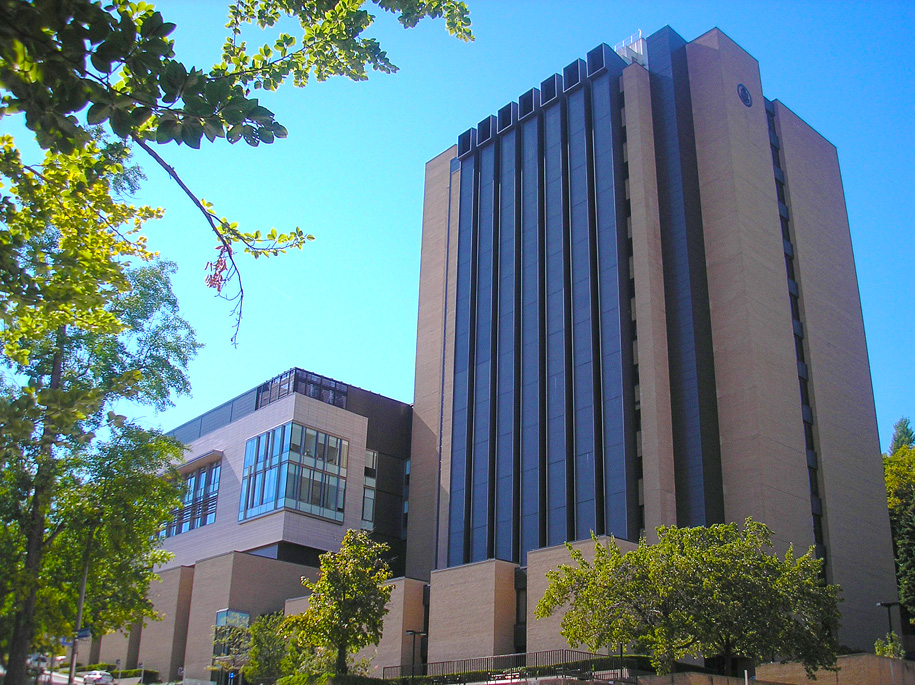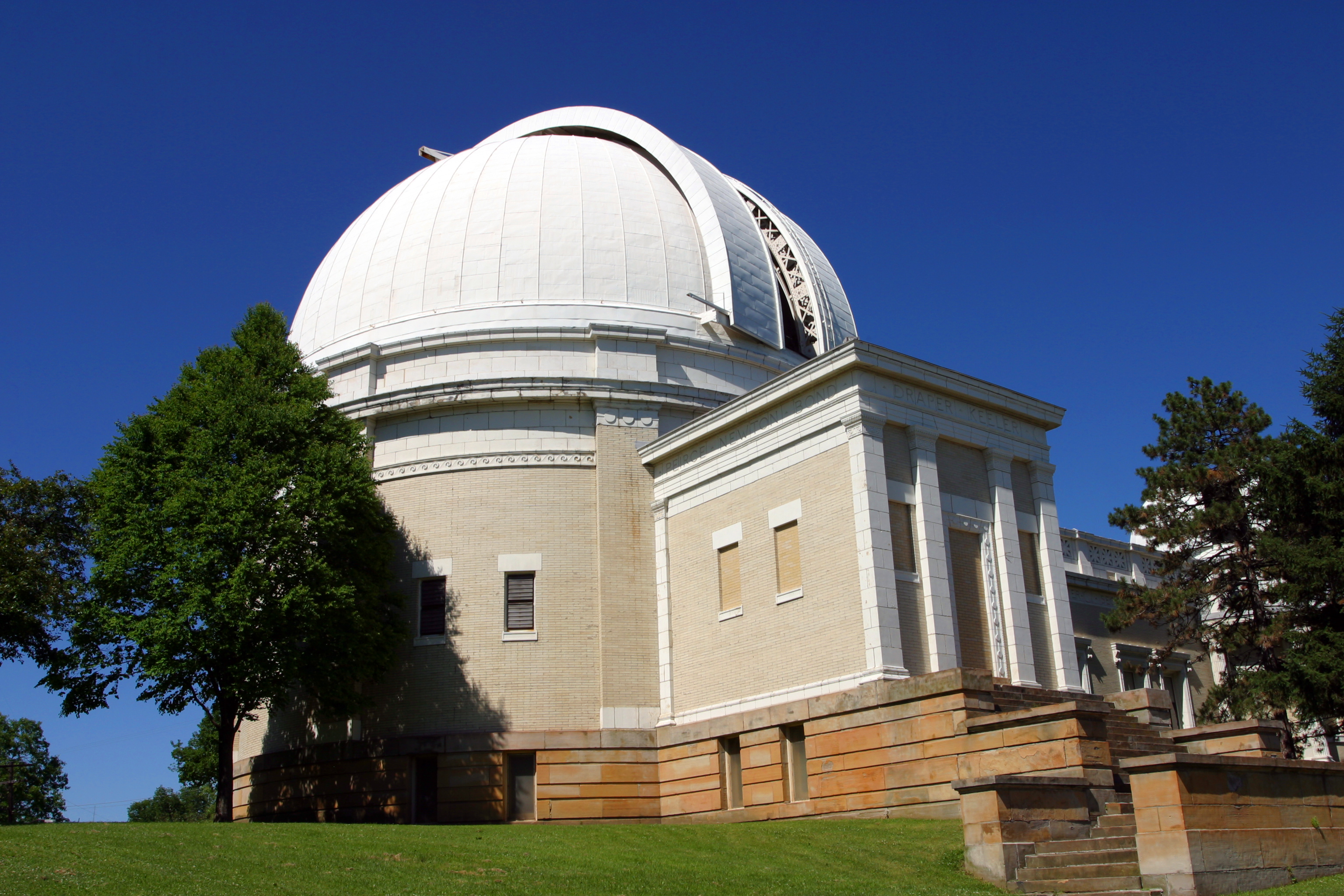|
Chevron Science Center
Chevron Science Center is a landmark academic building at 219 Parkman Avenue in Pittsburgh, Pennsylvania, United States on the campus of the University of Pittsburgh. The 15-story facility, completed in 1974, was designed by Kuhn, Newcomer & Valentour and houses the university's chemistry department. A three-story addition above Ashe Auditorium was completed in 2011. History Between 1910 and 1971, the site of Chevron Science Center had been occupied by the former State Hall, the first building erected upon Pitt's move in the early 20th century to the Oakland campus and at various times home to the university's library, administration, and engineering department. Chevron Science Center's $14.7 million cost ($ million today) was partially offset by a $2 million grant ($ million today) from the National Science Foundation. Its completion brought together under one roof many chemistry facilities that were, at the time, scattered among eight different buildings on Pitt's campus. Upon ... [...More Info...] [...Related Items...] OR: [Wikipedia] [Google] [Baidu] |
The Pitt News
''The Pitt News'' is an independent, student-written and student-managed newspaper for the main campus of the University of Pittsburgh in the Oakland neighborhood of Pittsburgh. The Pitt News has been active in some form since 1910 and is published Monday through Friday during the regular academic year and Wednesdays during the summer. About ''The Pitt News'' According to the constitution of ''The Pitt News'', the organization's purpose is "to prepare and publish a high-quality newspaper, to provide experience for its members in all facets of the journalism profession, to provide a voice for the students of the university, and to provide a public forum for the university community." ''The Pitt News'' is a million-dollar non-profit operation employing more than 100 undergraduate writers, roughly 25 students in the business division and three professional staff members. The paper includes five regular sections: News, Opinions, Culture, Sports, and Classifieds. It also produces abo ... [...More Info...] [...Related Items...] OR: [Wikipedia] [Google] [Baidu] |
Office Buildings Completed In 1974
An office is a space where an organization's employees perform administrative work in order to support and realize objects and goals of the organization. The word "office" may also denote a position within an organization with specific duties attached to it (see officer, office-holder, official); the latter is in fact an earlier usage, office as place originally referring to the location of one's duty. When used as an adjective, the term "office" may refer to business-related tasks. In law, a company or organization has offices in any place where it has an official presence, even if that presence consists of (for example) a storage silo rather than an establishment with desk-and-chair. An office is also an architectural and design phenomenon: ranging from a small office such as a bench in the corner of a small business of extremely small size (see small office/home office), through entire floors of buildings, up to and including massive buildings dedicated entirely t ... [...More Info...] [...Related Items...] OR: [Wikipedia] [Google] [Baidu] |
Skyscrapers In Pittsburgh
A skyscraper is a tall continuously habitable building having multiple floors. Modern sources currently define skyscrapers as being at least or in height, though there is no universally accepted definition. Skyscrapers are very tall high-rise buildings. Historically, the term first referred to buildings with between 10 and 20 stories when these types of buildings began to be constructed in the 1880s. Skyscrapers may host offices, hotels, residential spaces, and retail spaces. One common feature of skyscrapers is having a steel frame that supports curtain walls. These curtain walls either bear on the framework below or are suspended from the framework above, rather than resting on load-bearing walls of conventional construction. Some early skyscrapers have a steel frame that enables the construction of load-bearing walls taller than of those made of reinforced concrete. Modern skyscrapers' walls are not load-bearing, and most skyscrapers are characterised by large surface ... [...More Info...] [...Related Items...] OR: [Wikipedia] [Google] [Baidu] |
University And College Laboratories In The United States
A university () is an institution of higher (or tertiary) education and research which awards academic degrees in several academic disciplines. ''University'' is derived from the Latin phrase ''universitas magistrorum et scholarium'', which roughly means "community of teachers and scholars". Universities typically offer both undergraduate and postgraduate programs. The first universities in Europe were established by Catholic Church monks. The University of Bologna (), Italy, which was founded in 1088, is the first university in the sense of: *being a high degree-awarding institute. *using the word ''universitas'' (which was coined at its foundation). *having independence from the ecclesiastic schools and issuing secular as well as non-secular degrees (with teaching conducted by both clergy and non-clergy): grammar, rhetoric, logic, theology, canon law, notarial law.Hunt Janin: "The university in medieval life, 1179–1499", McFarland, 2008, , p. 55f.de Ridder-Symoens, Hilde' ... [...More Info...] [...Related Items...] OR: [Wikipedia] [Google] [Baidu] |
University Of Pittsburgh Academic Buildings
A university () is an institution of higher (or tertiary) education and research which awards academic degrees in several academic disciplines. ''University'' is derived from the Latin phrase ''universitas magistrorum et scholarium'', which roughly means "community of teachers and scholars". Universities typically offer both undergraduate and postgraduate programs. The first universities in Europe were established by Catholic Church monks. The University of Bologna (), Italy, which was founded in 1088, is the first university in the sense of: *being a high degree-awarding institute. *using the word ''universitas'' (which was coined at its foundation). *having independence from the ecclesiastic schools and issuing secular as well as non-secular degrees (with teaching conducted by both clergy and non-clergy): grammar, rhetoric, logic, theology, canon law, notarial law.Hunt Janin: "The university in medieval life, 1179–1499", McFarland, 2008, , p. 55f.de Ridder-Symoens, Hilde' ... [...More Info...] [...Related Items...] OR: [Wikipedia] [Google] [Baidu] |
Learning Research And Development Center
The Learning Research and Development Center (LRDC) at the University of Pittsburgh is an interdisciplinary center focused on describing, understanding, improving, and researching various aspects of human cognition and learning in order to improve and reform instruction and training in schools, the workplace, and informal environments. Overview Co-founded in 1963 by Robert Glaser and J. Steele Gow, it was among the first such centers in the world focusing on field of fundamental learning studies, and was selected for a program of the Cooperative Research Branch of the United States Office of Education as the first such center to provide a major concentration of effort in psychologically oriented education. Early funding support in 1968–1969 came by way of a $5.6 million grant ($ million today) from the U.S. Office of Education for facilities and a $1.2 million grant ($ million today) for program expansion from the National Science Foundation. Currently composed of 26 faculty ... [...More Info...] [...Related Items...] OR: [Wikipedia] [Google] [Baidu] |
List Of University Of Pittsburgh Buildings
The lists of University of Pittsburgh (Pitt) and University of Pittsburgh Medical Center (UPMC) buildings catalog only the currently-existing Pitt- and UPMC-owned buildings and structures that reside within the City of Pittsburgh, Pennsylvania, the home of the university's and medical center's main campuses. Although the University and the closely affiliated University of Pittsburgh Medical Center (UPMC) are tightly intertwined both institutionally and geographically, including the sharing and leasing arrangements of resources and facilities (such as Forbes Tower, Thomas Detre Hall, the Carrillo Street Steam Plant, Hillman Cancer Center, etc.), buildings primarily owned by UPMC are listed separately because the University and UPMC are technically separate legal entities. University of Pittsburgh The major concentration of buildings that comprise Pitt's main campus is centered in the Oakland neighborhood of Pittsburgh, however a few facilities are scattered elsewhere through ... [...More Info...] [...Related Items...] OR: [Wikipedia] [Google] [Baidu] |
Benedum Hall
Michael L. Benedum Hall of Engineering is a landmark academic building on the campus of the University of Pittsburgh in Pittsburgh, Pennsylvania, United States. The building was designed in the brutalist style by the architectural firm of Deeter, Ritchey, and Sippel and completed in 1971 at a cost of $15 million ($ million today). The building was honored with both the Pennsylvania Society American Institute of Architects Honor Award and Distinguished Building Award. It was built with a gift from the Claude Worthington Benedum Foundation and funds from the General State Authority. It stands on a site that was formerly occupied by the National Guard's Logan Armory. It is fifteen stories (two below ground) and has of space. It is home to the Swanson School of Engineering and contains classrooms, laboratories, offices, conference and seminar rooms, and is home to the George M. Bevier Engineering Library which serves not only the engineering school, but also the Department of ... [...More Info...] [...Related Items...] OR: [Wikipedia] [Google] [Baidu] |
University Of Pittsburgh Press
The University of Pittsburgh Press is a scholarly publishing house and a major American university press, part of the University of Pittsburgh. The university and the press are located in Pittsburgh, Pennsylvania, in the United States. The press publishes several series in the humanities and social sciences, including Illuminations—Cultural Formations of the Americas; Pitt Latin American Series; Pitt Series in Russian and East European Studies, Pittsburgh Series in Composition, Literary, and Culture; Pittsburgh/Konstanz Series in Philosophy and History of Science; Culture, Politics, and the Built Environment; Central Eurasia in Context, and Latinx and Latin American Profiles. The press is especially known for literary publishing, particularly its Pitt Poetry Series, the Agnes Lynch Starrett Poetry Prize, and the Drue Heinz Literature Prize. The press also publishes the winner of the annual Donald Hall Prize, awarded by the Association of Writers & Writing Programs and the wi ... [...More Info...] [...Related Items...] OR: [Wikipedia] [Google] [Baidu] |
Magnetic Resonance Imaging
Magnetic resonance imaging (MRI) is a medical imaging technique used in radiology to form pictures of the anatomy and the physiological processes inside the body. MRI scanners use strong magnetic fields, magnetic field gradients, and radio waves to generate images of the organs in the body. MRI does not involve X-rays or the use of ionizing radiation, which distinguishes it from computed tomography (CT) and positron emission tomography (PET) scans. MRI is a medical application of nuclear magnetic resonance (NMR) which can also be used for imaging in other NMR applications, such as NMR spectroscopy. MRI is widely used in hospitals and clinics for medical diagnosis, staging and follow-up of disease. Compared to CT, MRI provides better contrast in images of soft tissues, e.g. in the brain or abdomen. However, it may be perceived as less comfortable by patients, due to the usually longer and louder measurements with the subject in a long, confining tube, although "open ... [...More Info...] [...Related Items...] OR: [Wikipedia] [Google] [Baidu] |
Paul Lauterbur
Paul Christian Lauterbur (May 6, 1929 – March 27, 2007) was an American chemist who shared the Nobel Prize in Physiology or Medicine in 2003 with Peter Mansfield for his work which made the development of magnetic resonance imaging (MRI) possible.Filler, AG: The history, development, and impact of computed imaging in neurological diagnosis and neurosurgery: CT, MRI, DTINature Precedings . Lauterbur was a professor at Stony Brook University from 1963 until 1985, where he conducted his research for the development of the MRI. In 1985 he became a professor along with his wife Joan at the University of Illinois at Urbana-Champaign for 22 years until his death in Urbana. He never stopped working with undergraduates on research, and he served as a professor of chemistry, with appointments in bioengineering, biophysics, the College of Medicine at Urbana-Champaign and computational biology at the Center for Advanced Study. Early life Lauterbur was of Luxembourgish ancestry. Born ... [...More Info...] [...Related Items...] OR: [Wikipedia] [Google] [Baidu] |






